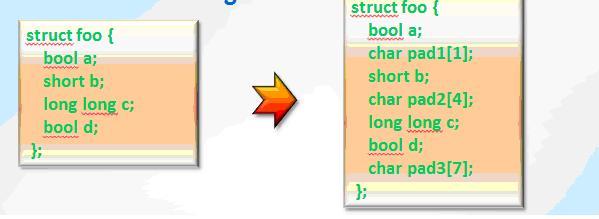Optimizing compiler. Vectorization
Data alignment
Information about the alignment can be obtained with intrinsic __alignof__. The size and the default alignment of the variable of a type may depend on the compiler. (ia32 or intel64)
printf("int: sizeof=%d align=%d\n",sizeof(a),__alignof__(a));
Alignment for ia32 Intel C++ compiler:
bool sizeof = 1 alignof = 1 wchar_t sizeof = 2 alignof = 2 short int sizeof = 2 alignof = 2 int sizeof = 4 alignof = 4 long int sizeof = 4 alignof = 4 long long int sizeof = 8 alignof = 8 float sizeof = 4 alignof = 4 double sizeof = 8 alignof = 8 long double sizeof = 8 alignof = 8 void* sizeof = 4 alignof = 4
The same rules are used for array alignment.
There is the possibility to force the compiler to align object in a certain way:
__declspec(align(16)) float x[N];
The order of fields in the structure affects the size of the object of a derived type. To reduce the size of the object structure fields should be sorted by descending of its size. You can use __declspec to align structure fields.
typedef struct aStuct{
__declspec(align(16)) float x[N];
__declspec(align(16)) float y[N];
__declspec(align(16)) float z[N];
};
Loop vectorization usually produces three loops: loop for non-aligned staring elements, vectorized loop and tail. Vectorization of loop with small number of iterations can be unprofitable.
Additional vectorization example
Vector.c
void Calculate(float * a,float * b,
float * c , int n) {
int i;
for(i=0;i<n;i++) {
a[i] = a[i]+b[i]+c[i];
}
return;
}
First argument alignment differs
Main.c
#include <stdio.h>
#define N 1000
extern void Calculate(float *,float *, float *,int);
int main() {
float x[N],y[N],z[N];
int i,rep;
for(i=0;i<N;i++) {
x[i] = 1;y[i] = 0; z[i] = 1;
}
for(rep=0;rep<10000000;rep++) {
Calculate(&x[1],&y[0],&z[0],N-1);
}
printf("x[1]=%f\n",x[1]);
}
icl main.c vec.c -O1 –FeA
time a.exe 12.6 s.
- Compiler makes auto vectorization for –O2 or –O3.
Option -Qvec_report informs about vectorized loops. icl main.c vec.c –O2 –Qvec_report –Feb vec.c(3): (col. 3) remark: LOOP WAS VECTORIZED. time b.exe 3.67 s.
Vectorization is possible because the compiler inserts run-time check for vectorizing when some of the pointers may be not aliased. The application size is enlarged.
-
void Calculate(float * resrtict a,float * restrict b, float * restrict c , int n) {To restrict align attribute we need to add option –Qstd=c99
icl main.c vec.c –Qstd=c99 –O2 –Qvec_report –Fec vec.c(3): (col. 3) remark: LOOP WAS VECTORIZED. time c.exe 3.55 s.
Small improvement because of avoiding run-time check
Useful fact: For modern calculation systems performance of aligned and unaligned instructions almost the same when applied to aligned objects.
-
int main() { __declspec(align(16)) float x[N]; __declspec(align(16)) float y[N]; __declspec(align(16)) float z[N]; Calculate(&x[0],&y[0],&z[0],N-1); void Calculate (float * resrtict a,float * restrict b, float * restrict c , int n) { Int n; __assume_aligned(a,16); __assume_aligned(b,16); __assume_aligned(c,16); icl main.c vec.c –Qstd=c99 –O2 –Qvec_report –Fed vec.c(3): (col. 3) remark: LOOP WAS VECTORIZED. time d.exe 3.20 s.This update demonstrates improvement because of the better alignment of vectorized objects. Arrays in main are aligned to 16. With this update all argument pointers are well aligned and the compiler is informed by __assume_aligned directive. It allows to remove the first scalar loop.
Data alignment
Good array data alignment for SSE: 16B for AVX: 32B
-
Data alignment directives:
- C/C++
- Windows: __declspec(align(16)) float X[N];
- Linux/MacOS: float X[N] __attribute__ ((aligned (16));
- Fortran !DIR$ ATTRIBUTES ALIGN: 16:: A
- C/C++
- Aligned malloc
- _aligned_malloc()
- _mm_malloc()
-
Data alignment assertion (16B example)
- C/C++: __assume_aligned(p,16);
- Fortran: !DIR$ ASSUME_ALIGNED A(1):16
- Aligned loop assertion
- C/C++: #pragma vector aligned
- Fortran: !DIR$ VECTOR ALIGNED
Non-unit stride and unit stride access
Well aligned data is better for vectorization because in this case vector register is filled by the single operation. In case with non-unit stride access to array, register filling is more complicated task and vectorization is less profitable.
Auto vectorizer cooperates with loop optimizations for improving access to objects.
There are compiler directives which recommend to make vectorization in case when compiler doesn’t make it because it looks unprofitable.
C/C++
#pragma vector{aligned|unaligned|always}
#pragma novector
Fortran
!DEC$ VECTOR ALWAYS !DEC$ NOVECTOR
Vectorization of outer loop
Usually auto vectorizer processes the nested loop. Vectorization of the outer loop can be done using "simd" directive.
#define N 200
#include<stdio.h>
int main() {
int A[N][N],B[N][N],C[N][N];
int i,j,rep;
for(i=0;i<N;i++)
for(j=0;j<N;j++) {
A[i][j]=i+j;
B[i][j]=2*j-i;
C[i][j]=0;
}
for(rep=0;rep<10000000;rep++) {
#pragma simd
for(i=0;i<N;i++) {
j=0;
while(A[i][j]<=B[i][j] && j<N) {
C[i][j]=C[i][j]+B[j][i]-A[j][i];
j++;
}
}
}
printf("%d\n"C[0][2]);
}
icl vec.c -O3 -Qvec- -Fea (Qvec- disable vectorization) 20.7 s icl vec.c -O3 -Qvec_report -Feb 17.s vec.c(17): (col. 3) remark: SIMD LOOP WAS VECTORIZED.


